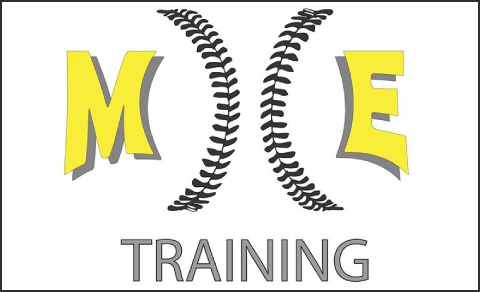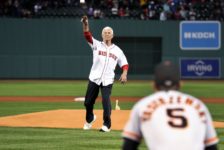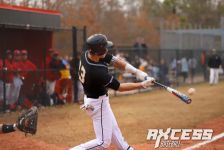When the 1988 Baltimore Orioles set a record for futility by starting the season with a record of 0-21, they were searching for ways to sell tickets by the end of the season.
They called on one of their three first round picks–the only one that actually signed with the team–from the previous season. It was a right-handed pitcher out of Fordham University that just finished a decorated collegiate career with a record of 21-3 and a 2.29 ERA.
His name was Pete Harnisch, a graduate of Commack HS.
“It was a different era,” said Harnisch who made his debut just over a year after signing a pro contract. “They kept moving me up because I was pitching well. It’s not like today where they move guys along slowly so they don’t lose their confidence. The big league team was pretty bad so they wanted to move me along quick,” he added.
In that big league debut, he had a pretty memorable outing. Pitching at legendary Fenway Park, he walked future Hall of Fame Wade Boggs on eight pitches. Two batters later, he struck out Dwight Evans for his first career punch out on a 2-2 slider.
Later, he allowed a grand slam to another future Hall of Fame Jim Rice. Despite that, he wound up completing seven innings, yielding five runs and getting tagged with the loss.
His first three seasons in the big leagues, he compiled a record of 16-22 and was traded to the Houston Astros.
It was there where he really turned around his career in 1991 and became an All Star. He threw 216.2 IP with a stellar ERA of 2.70. He was 29 percent better than the average starter according to ERA+.
“I really started to figure it out in the second half of ’89,” said Harnisch. “I loved my pitching coach and started getting comfortable being a big leaguer. By ’91 I really started to learn how to make adjustments,” he added.

Another big moment in his career was in 1995 when he was traded back to his hometown state of New York to play for the Mets.
Despite growing up a Yankee fan, he noted that it was a surreal moment.
“At that time I was living in Jersey so it was only about 65 miles to the stadium. I would commute every day when we had a home game. It was really nice to be home and see my parents,” he added.
He noted that those Met teams were not very good, as they were still in the midst of paying the price for the bad contracts that weighed down their roster with aging players like Bret Saberhagen and Bobby Bonilla.
He played with the Mets until 1997–a much improved team that featured a younger, more athletic core.

Shortstop Rey Ordonez, who would later go on to set an MLB record by not committing an error in 100 consecutive games, was someone that stands out. He spoke glowingly of his defensive prowess.
“When Rey came over he was still adjusting and figuring it out, but he would make some plays that would make you go ‘WOW’. He would make plays that nobody else could make. He was a throwback to Ozzie Smith–he was probably the only other player that could make the plays that he could make. He still had some times when he would miss a routine play and have it hit off his glove but then he would make an unbelievable play,” he added.
He also mentioned Edgardo Alfonzo as someone he enjoyed playing with.
“He has to be in my top 5 favorite teammates,” he said. “He was just a great player he could do everything–he hit behind runners, could hit with two strikes, he would get a big hit when you needed and played a great second base, but could also play shortstop or third if you needed,” he added.

Another interesting moment in his career was in 1999 when he was the ace of the Cincinnati Reds. Coming off a great 1998 season in which he won 14 games with a 3.14 ERA, he followed that up with 16 wins and a 3.68 ERA. As we now know, the offensive numbers during that period were artificially enhanced, meaning that 3.68 ERA was actually 27 percent better than the average NL starter.
With the Reds leading the NL Wild Card by 2 games with 3 remaining, he was scheduled to be their Game 1 starter in the NLDS against the Arizona Diamondbacks. Then a funny thing happened–the team trailing the Reds, the Mets, decided they wouldn’t lose. They suddenly went into the final game of the season just 1 game back with one remaining. The Reds also lost the first two games of their series to the dreadful Milwaukee Brewers.

“They were awful that season and they basically had their bags packed going into that final series of the season, but they somehow beat us the first two games of the series.”
Needing to win to win to avoid squandering a playoff spot completely, Harnisch took the ball and responded with 5.2 shutout innings in a 7-1 win for the Reds. The Mets won their game against the Pittsburgh Pirates on a wild pitch to score Melvin Mora to force a one-game playoff. Game 163.
It was held in Cincinnati but the Mets had the advantage with ace Al Leiter on the hill. The NJ native was outstanding, firing a two-hit shutout to secure a 5-0 victory for the Mets to advance to the face Arizona.
“I’ve talked to Al about it since then and he’ll tell you he was lights-out for the last seven innings but I don’t think he threw a strike for the first two innings. He had the jitters early and we swung at a lot of pitches out of the strike zone,” he added.

“That’s one that kind of sticks in my craw,” he said.
In his final season of 2001, Harnisch had the fortune of playing with some interesting characters.
One of the greatest players of all-time, Ken Griffey Jr., was 31 but still a power threat with a .533 SLG percentage.
“Griffey is great,” he said. “I still see him from time-to-time in Spring Training he talks to the minor leaguers. When we played together he wasn’t the same player that he was in his younger days with Seattle but he was still very good,” he added.

First basemen Sean Casey, now an analyst on MLB Network and nicknamed “The Mayor” for his bubbly personality was another favorite of Harnisch.
“He’s the same guy that you see on TV–that’s the real him. He is one of my favorites–one of the top 10 people on this planet. He comes from a great family, he’s got great parents,” he added.
Lastly, he played with Aaron Boone. Baseball fans know him as the current manager of the most famous team in North American sports, but before that he was a third baseman for the Reds. Coming from an all-time baseball family that featured three generations of big leaguers and four in total, Boone is now the most high-profile but he was not always the most talented player.
“No,” he said when asked if he knew he was destined to become a big league manager some day. “But I wasn’t shocked,” he added. “He’s a great guy, he’s actually in my fantasy football league that I’ve been running for 20 years. He’s a character with a great personality. His biggest trait is relating to people and I think that’s where the previous manager failed–he could no longer relate to the younger player,” he added.

The previous manager is Joe Girardi, who was just named the manager of the Philadelphia Phillies after being in consideration for the Mets managerial position. One of the finalists, Tim Bogar, is another friend of Harnisch. They were drafted in the now-infamous 1987 draft that featured two Hall of Famers (Griffey Jr and Craig Biggio), as well as dozens of other impact players like Albert Belle, Travis Fryman, Jack McDowell. Kevin Appier, Delino Deshields, Derek Bell and more.
Bogar, who is currently the first base coach for the Nationals, is said to be very well-respected and intelligent.
“If they choose him, that would be very smart of them,” said Harnisch.
![]()
These days, Harnisch is still involved with baseball. He’s the roving pitching instructor for the Seattle Mariners. Additonally, his son Jack is an infielder at Fordham University and played in the HCBL this past summer.
He has some strong opinions on the current state of baseball–specifically pitching.
“I think the entire brand of baseball has changed–and not for the better,” he said. “I think we’re grooming the pitchers wrong. Guys are being told to get 15 outs. In the minor leagues it’s even worse because they’re being handled so carefully,” he added.

Harnisch threw 24 complete games (11 shutouts) during his career and feels that pitchers should be asked to go longer.
“I came up in an era when pitchers wanted to finish what they started. There’s maybe 10 or 15 guys like that in the big leagues right now–like Justin Verlander and Max Scherzer. When I came up it was really the early days of the closer. The closer was really a one-inning guy that came in after the starter couldn’t go anymore. Then during the middle of my career we saw the set-up man. Now the game is so specialized–there’s a reliever for every inning. I think it will come full circle though because we are seeing guys that just have ‘stuff.’ They throw as hard as they can but if they don’t have their command then they can’t make the adjustment and figure it out. When I played I went full bore until the manager took the ball from me.”
Harnisch compiled a career record of 111-103 and an ERA of 3.89 over his 14-year career, which puts him right in that upper-tier of Long Islanders that have played in the big leagues behind Craig Biggio and Carl Yastrzemski.
Before that though, he was just a regular kid from Long Island. Growing up in Commack as the fifth oldest of seven, he knew the value of working hard.
“We took the bus everywhere,” he said. “My mother never drove and my father didn’t make a whole lotta money,” he added.
Harnisch admits he was never the most talented. In fact, he played JV as a 10th grader and actually entered his junior year as a reliever. The Commack North varsity team had three starters that coach trusted and they began the season that way.
It wasn’t until an injury occurred to one of the starters that Harnisch even was given an opportunity to start.
“We were in a tournament in Kings Park and I struck out three batters in my inning. I wasn’t throwing that hard–maybe 85. A couple scouts were there. A Giants and a Reds scout had me fill out draft cards–just basic information. I actually was planning on going to Eckerd College–a really good Division-II school in St. Petersburg, FL–until I got approached by Dan Gallagher the coach of Fordham. The next winter he had me come down in January to the school and I really loved being in the Bronx. It’s not the typical story you hear now. It wasn’t that way when I was in high school. There was no early-commits–you got recruited your senior year.”
From 85 MPH to 95 MPH in three years at Fordham is what made him go from a middling-recruit to a first round pick. He credits his pitching coach, Mike Bruhert, with that increased velocity. He was a former big league pitcher with the 1978 Mets. The ironic thing about his collegiate career is that he lost only three games and one of them was a 2-1 loss to the 1-17 St. Peter’s University team.
Aside from that loss, he was arguably the best pitcher in Fordham’s storied history and carved his way into their record books.
While Harnisch may not be the first name you think of when the topic of famous Long Island baseball players come up, he deserves to be in that conversation for the longevity and quality of his career.















